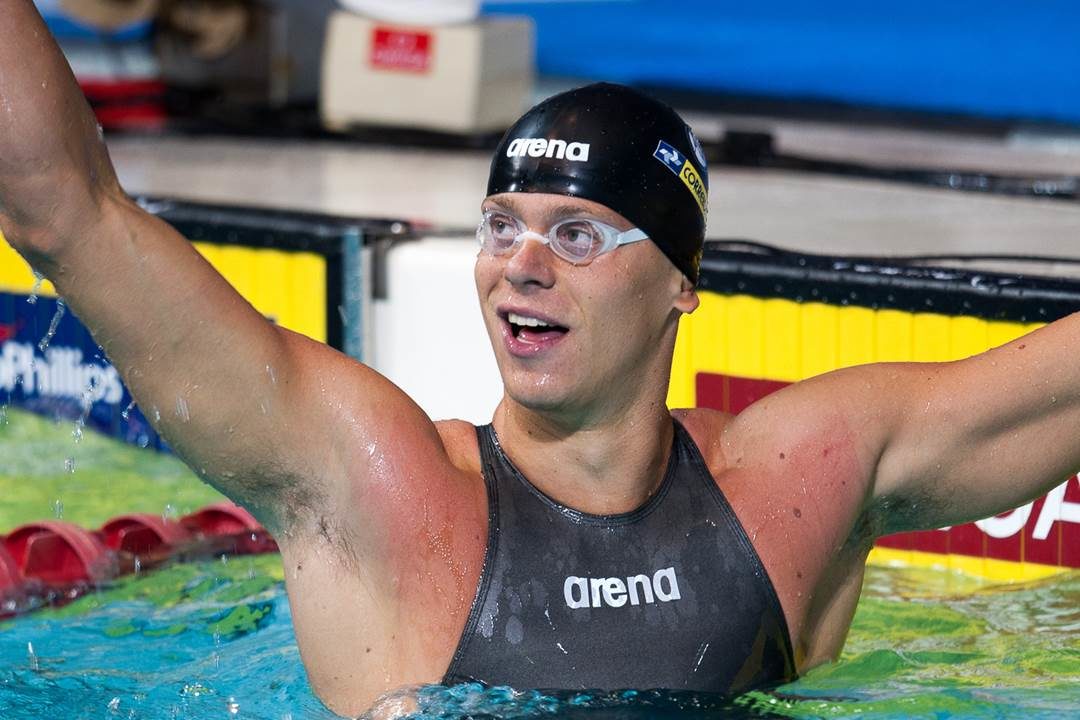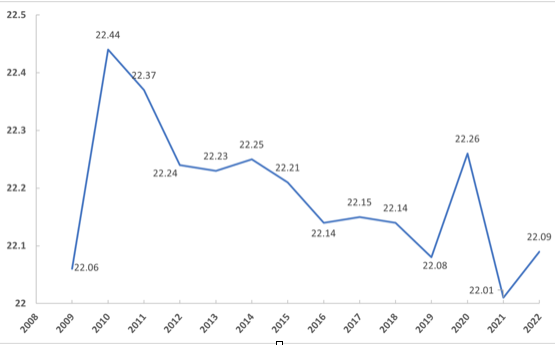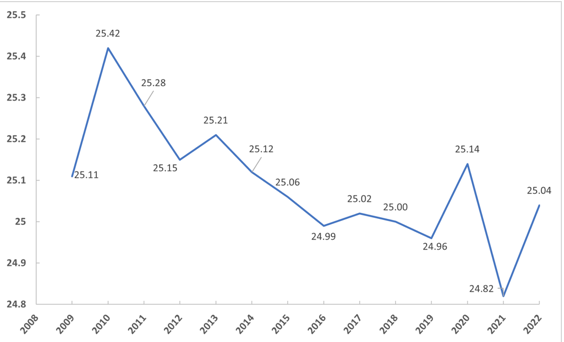This article originally appeared in the Spring 2023 issue of SwimSwam magazine. Subscribe here.
It’s been 13 years since high-tech swimsuits were banned from swimming. But they are far from being just a distant memory.
The impact they made between 2008 and 2009 was huge, since they were used by almost every elite swimmer in that period and were instrumental in breaking several world records. Some of these records still stand today, such as Cesar Cielo’s 50 freestyle, Michael Phelps’ 400 IM, and Federica Pellegrini’s 200 freestyle.
It is undeniable that swimmers were able to swim much faster because of the suits. At that time, they set records that were way beyond our imagination. Even today, some of them seem untouchable, like Paul Biedermann’s 200 freestyle, Zhang Lin’s 800 freestyle, and Liu Zige’s 200 butterfly.
On the other hand, some other very fast world records from that period have been broken in past years. In 2022, we saw one of them: David Popovici in the men’s 100 freestyle, breaking the 13-year-old world record by Cesar Cielo from the 2009 World Championships in Rome.
Overall, on average, have the current swimmers been swimming faster than the super-suited swimmers from the 2008-2009 era? This is the question we are going to try to answer.
THE LEGACY OF THE SUITS
In 2008, Speedo launched the LZR Racer suit, adding polyurethane panels to its existing design and replacing the Teflon coating used in previous models. The more polyurethane the suits had, the less drag they created. The result was 55 world records broken in that year in long course meters — 25 of those during the Beijing Olympics.
In 2009, other manufacturers like Jaked and Arena went further and made their suits entirely with polyurethane, allowing the swimmers to glide through the water even faster. Sixty-seven world records were broken that year in long course meters — 43 at the World Championships in Rome — the most ever.
At the beginning of 2010, World Aquatics banned those suits for good. Now, swimsuits have to be made with only textile materials, no polyurethane.
It is true that, as of today, several of the fastest performances of all time were set in that period. And some of them still seem ahead of our time.
But swimming has evolved, and most of the world records set in high-tech suits have already been surpassed. From the 34 individual events officially recognized by World Aquatics in long course meters, 26 have seen world records set from 2010 on.
Aside from the world records, it is also interesting to analyze which events have been showing the most improvement compared to the super-suits era.
A 2009 X 2022 COMPARISON
Let’s take a look at the top 25 all-time performers’ rankings, in each event. Putting it into perspective, by the end of 2009, most of those rankings were dominated by performances set in 2008 and 2009. For example, in the men’s 100 butterfly, Ian Crocker (50.40 in 2005, a world record by then) was the only swimmer who appeared among the 25 fastest performers ever with a swim before 2008 – all the other 24 swimmers had set their fastest times in 2008 and 2009.
Considering all the 34 individual events, which means 34 x 25 = 850 records, 666 (78.4%) had been set in the super-suit era by the end of 2009.
What about today? How many of those swims are left in the rankings?
By the end of 2022, 188 (22.1%) of all those 850 records were set in 2008 and 2009.
The men’s 50 freestyle top 25 all-time rankings are still quite dominated by that era, with 12 super-suited swimmers – ones like Cesar Cielo, Frederick Bousquet, Ashley Callus, George Bovell, Alain Bernard, Amaury Leveaux and Eamon Sullivan.
In fact, swimmers from that era tend to appear more in the men’s historical rankings than in women’s rankings. The men’s 100 freestyle (10), 200 butterfly (10), 100 backstroke (9), and 50 butterfly (8) top the list. Only then does a women’s event appear, the 100 breaststroke (8).
It checks out, since women were seemingly able to reach the 2008-2009 level before men. After all, in the years that followed the super-suit ban, we saw many more world records in women’s events than in men’s events, up until 2017. Since 2018, there have been more world records in men’s events.
This can be seen in the world records table: In long course meters, six men’s world records in individual events from that era still survive. On the women’s side, there are only two.
On the other hand, as of today, only two performers from 2008-2009 appear in women’s 1500 freestyle and the men’s 50 breaststroke top 25 all-time rankings. If we look at only the Olympic events (women’s 1500 freestyle was not an Olympic event at that time), only three swimmers from the super-suit era appear in women’s 100 freestyle and 100 backstroke, and men’s 200 breaststroke.
Number of Performers from the Super-Suit Era (2008-2009) in the Top 25 All-time Rankings in 2009 and 2022
| Event | Men’s | Women’s | ||
| 2009 | 2022 | 2009 | 2022 | |
| 50 Freestyle | 23 | 12 | 18 | 6 |
| 100 Freestyle | 23 | 10 | 23 | 3 |
| 200 Freestyle | 21 | 6 | 21 | 4 |
| 400 Freestyle | 17 | 6 | 17 | 5 |
| 800 Freestyle | 15 | 4 | 10 | 5 |
| 1500 Freestyle | 12 | 4 | 5 | 2 |
| 50 Backstroke | 24 | 4 | 22 | 3 |
| 100 Backstroke | 23 | 9 | 24 | 3 |
| 200 Backstroke | 19 | 7 | 18 | 5 |
| 50 Butterfly | 24 | 8 | 21 | 5 |
| 100 Butterfly | 24 | 7 | 18 | 7 |
| 200 Butterfly | 19 | 10 | 19 | 7 |
| 50 Breaststroke | 22 | 2 | 18 | 5 |
| 100 Breaststroke | 24 | 4 | 21 | 8 |
| 200 Breaststroke | 24 | 3 | 19 | 4 |
| 200 Medley | 23 | 4 | 21 | 5 |
| 400 Medley | 19 | 5 | 15 | 6 |
So it seems that in a few years, in some events, there will be no sign of super-suited swimmers among the fastest of all time.
HAVE THE CURRENT SWIMMERS SURPASSED THE 2008-2009 LEVEL OF PERFORMANCE?
Let’s take a look at the average time evolution analyzing some deeper rankings, the top 100 world rankings by year. We will try to determine if, on average, the current swimmers have surpassed the 2008-2009 level of performance.
For example, in 2009, the average time of the 100 fastest swimmers in the world in the men’s 50 freestyle was 22.06. After the suit ban, this average increased to 22.44 in 2010. Then the average started to decrease, and only in 2021 was it faster than 2009, 22.01.
Average Time of the Top 100 Performers by Year in Men’s 50 Freestyle (2009-2022)
It is important to notice that typically this average tends to increase in the year that follows the Olympic year, in all events. In the men’s 50 freestyle, it was 22.09 in 2022, higher than 2009.
In the women’s 50 freestyle, on the other hand, the average time of the top 100 performers in 2015 was faster than in 2009.
Average Time of the Top 100 Performers by Year in Women’s 50 Freestyle (2009-2022)
This pattern is seen in other events – women reaching the 2008-2009 level way before men. For example, in 2012, the average times in four women’s events and only one men’s event were faster than in 2009.
Interestingly, 2015 seems to be a turning point. In 2014, nine events had their average time faster than in 2009. In 2015, it was 20. And this number has only been increasing.
Average Time of the Top 100 Performers in 2009 and 2022 by Event
| Event | Men’s | Women’s | ||
| 2009 | 2022 | 2009 | 2022 | |
| 50 Freestyle | 22.06 | 22.09 | 25.11 | 25.04 |
| 100 Freestyle | 48.58 | 48.56 | 54.58 | 54.36 |
| 200 Freestyle | 1:47.30 | 1:47.10 | 1:58.33 | 1:58.18 |
| 400 Freestyle | 3:49.07 | 3:48.88 | 4:09.79 | 4:09.81 |
| 800 Freestyle | 7:59.38 | 7:56.16 | 8:34.93 | 8:35.58 |
| 1500 Freestyle | 15:14.80 | 15:13.01 | 16:37.03 | 16:28.01 |
| 50 Backstroke | 25.37 | 25.11 | 28.72 | 28.26 |
| 100 Backstroke | 54.29 | 54.20 | 1:00.87 | 1:00.49 |
| 200 Backstroke | 1:58.46 | 1:58.46 | 2:10.88 | 2:11.26 |
| 50 Breaststroke | 27.69 | 27.47 | 31.35 | 31.21 |
| 100 Breaststroke | 1:00.48 | 1:00.27 | 1:07.72 | 1:07.67 |
| 200 Breaststroke | 2:11.33 | 2:11.08 | 2:26.07 | 2:26.36 |
| 50 Butterfly | 23.64 | 23.45 | 26.61 | 26.34 |
| 100 Butterfly | 52.03 | 51.93 | 58.52 | 58.51 |
| 200 Butterfly | 1:56.95 | 1:57.16 | 2:09.13 | 2:10.29 |
| 200 Medley | 2:00.06 | 1:59.63 | 2:13.11 | 2:13.39 |
| 400 Medley | 4:16.89 | 4:16.76 | 4:41.84 | 4:43.55 |
In 2021, only two events had the top 100 average times higher than in 2009: women’s 200 butterfly and 400 IM. In 2022, it was eight events. In the table above, we can see that, in most events, the average times from 2009 and 2022 are very close. In most events, on average, the swimmers have been swimming as fast as, or even faster, than in the super-suit era. But not that much.
We can say that the 2008-2009 performances were way ahead of their time because of their suits. By this analysis, it seems that only now swimmers are at the same level of the super-suited swimmers from 13-14 years ago. They were more than a decade ahead of their time.



They were NOT ahead of their time. The suits made swimmers look faster than they actually would have been without the suits. Did they train hard? Yes, of course. Did they win medals? Yes, of course. But were they really faster than swimmers without those suits lifting them, reducing drag and resistance, and allowing them to hold less resistive line and balance than their muscle alone would have allowed? (Mary T. would have WON the 2024 World champs by a second and a half with no goggles and a regular swim suit cut at the hips — she went 2:05.9 in 1981). And, was it (and is it) easier to maintain speed because of the kayaks they were wearing and… Read more »
The look of the super suits was ugly and terrible. It probably turned off more people entering the sport.
To improve the analysis at the end of the article you could use a trend line post suit ban to get a better estimation of where the times are today.
2 times will last forever.
I am confident in saying that.
Zhang and Zige
All those events need is a male Ledecky or female Milak to break those records. Ofc, that’s easier said than done
I think the supersuit conversation minimizes what athletes from 2000-2009 did for the sport of swimming. First, not all supersuits were the same. For example, those old Jakeds were literally built differently than LZRs. Anyone who wore both will know what I mean. But does that mean that Biederman or Cielo couldn’t have found the top of the podium wearing different suits? Sure, Maybe Phelps wins that 200 Free in Rome. Maybe Cielo and Bousquet don’t break 21, and likely the world record board would have looked different… but the sport was attempting to adapt to new technologies. And it made swimming relevant to a lot of casual fans.
Despite being textile, I think modern suit tech is actually… Read more »
I would say that both the tech and textile suits have been a net positive for the swimsuit manufacturers. And yes times may have improved but they have made this sport an increasingly more expensive sport for the average family. That in the long run may not be healthy for the sport.
There is 0 shot that the mens suits now are more beneficial than the supersuits, because of the coverage.
I’m willing to accept the possibility modern womens suits are better in some regards.
I don’t really get the car analogy. Like, a better car makes it easier to do laps faster, but your skill has to adapt and improve to adjust with it.
Super suits literally just made you swim faster with less effort and you didn’t have to do anything for that benefit.
I don’t think supersuit era swimmers were bad. But there is no denying that a lot of the insane times are mostly a result of the suit. If you compare the best suited time vs best textile time for a few of those swimmers the result is ridiculous. Some of them swam supersuit times that are still untouchable while their textile PBs wouldn’t even make a final right now.
The W200 FLY won’t be broken for a few more years.
Looking at all the top 100 average times by women’s events and comparing them to the world championship a standards the biggest outlier is the 200 fly. The average time is 210.29 and the a cut 209.21. In fact outside of the 100 back and 200,400,800 and 1500 every other event a standard is faster than the average with the 200 fly being the significant outlier. Maybe world aquatics needs to rethink some of these cuts based on data. If they did maybe they would get more kids sticking with 200 fly and more than 32 entries at the world championships and the 20 plus they got at the Olympics.
Good point. Ledeky has often said, 200 fly was her best event when she was young. If she had put her focus on fly rather than distance free, that record might be toast. I say might, because one never knows. Perhaps she just got too tall, my personal opinion, the best flyers are not exceptionally tall.
Two words – Michael Phelps
This article from last year is a good one to compare super suit times with textile times: https://staging2.swimswam.com/what-if-the-super-suits-had-not-been-banned-in-2010/
But yes, I’d say some were definitely ahead of their time. The Women’s 200 Fly LCM WR is, in my opinion, definitely still more impressive than any swim in textile has been. Others that have a strong case are:
Men’s 200 Free LCM WR… Read more »
Men’s 800 Free LCM WR
Men’s 200 Back LCM WR
Men’s 4×100 Free Relay LCM WR (as they were in 2008 suits)
Men’s 800 Free SCM WR (again, 2008 suit)
Fred Bousquet’s 20.94 50 LCM free (No wedge on the block, I think I read that those are worth .2-.3)
Thanks I had missed that one which is mostly what I was looking for though I’m still not clear if they did the regressions per event or just based off one event. Really I should just get the data and do the work myself instead of asking others. I guess I want to know, but not that badly. LOL
if we’re adding asterisks to those, the 200back was in a leg suit. still my vote for craziest record considering the talent in that event since then
That’s a good point. It also makes me wonder how much worse, if at all, today’s women’s suits really are compared to the 2008 and 2009 suits.
Cielo 20.91 was done without wedge too
He did have a wedge, though whether he had enough practice at that point on it to be .2-.3 faster is debatable
https://www.youtube.com/watch?v=QnmEgFUVFjk
I’d like to add to Bousquet that he went 18.76 in 2005 and knowing that he was 20.94 in LCM and 19.9 in SCM on a relay had he swim the NCAA in 2008-09 he almost certainly would have broken 18 in yards probably would have gone 17.8
What I want to see, now that we have enough data points after the super suit error is going back to 1995 or 13 years before to match the 13 years after, then creating the average trend line of the progression of the top 100/25/5 each year, without the 08 and 09 data. Find the 08 and 09 expected times from the trends line. Compare that to the actual data.
I’ve seen several estimates of how much faster the super suits made people, but they were all done before and during the super suit era. I’d like to see that dive with more data now.
I still wonder how long Thorpe’s textile 400 free record will stand. Multiple… Read more »